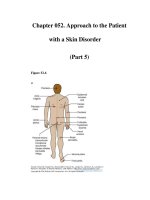Chapter 052 Approach to the Patient with a Skin Disorder (Part 1) ppt

Chapter 052. Approach to the Patient with a Skin Disorder (Part 1) ppt
... Harrison's Internal Medicine > Chapter 52. Approach to the Patient with a Skin Disorder APPROACH TO THE PATIENT WITH A SKIN DISORDER: INTRODUCTION The challenge of examining the skin ... interpretation would be that the patient has a pruritic eczematous dermatitis with erosions caused by scratching. Figure 52-1 Chapter 052. Approa...
Ngày tải lên: 06/07/2014, 20:20

Chapter 052. Approach to the Patient with a Skin Disorder (Part 5) pptx
... Psoriasis. This papulosquamous skin disease is characterized by small and large erythematous papules and plaques with overlying adherent silvery scale. Figure 52-8 Chapter 052. Approach to ... overlying adherent silvery scale. Figure 52-8 Chapter 052. Approach to the Patient with a Skin Disorder (Part 5) Figure 52-6
Ngày tải lên: 06/07/2014, 20:20

Chapter 052. Approach to the Patient with a Skin Disorder (Part 7) ppt
... atopy, psoriasis, or acne) 10. Social, sexual, or travel history as relevant to the patient DIAGNOSTIC TECHNIQUES Many skin diseases can be diagnosed on gross clinical appearance, but sometimes ... technique, a punch is pressed against the surface of the skin and rotated with downward pressure until it penetrates to the subcutaneous tissue. The circular biops...
Ngày tải lên: 06/07/2014, 20:20

Chapter 052. Approach to the Patient with a Skin Disorder (Part 8) pptx
... Figure 52-11 Chapter 052. Approach to the Patient with a Skin Disorder (Part 8) Tzanck Smear A Tzanck smear is a cytologic technique most often used in the diagnosis of herpesvirus ... against a lesion and noting the amount of blanching that occurs. Granulomas often have an opaque to transparent, brown-pink "apple jelly" appearance on dias...
Ngày tải lên: 06/07/2014, 20:20

Chapter 052. Approach to the Patient with a Skin Disorder (Part 2) potx
... common primary skin lesions (see Table 52 -1). Chapter 052. Approach to the Patient with a Skin Disorder (Part 2) Table 52-2 Description of Secondary Skin Lesions Lichenification: A distinctive ... predominant symptom of inflammatory skin diseases (e.g., atopic dermatitis, allergic contact dermatitis); it is also commonly associated with xerosis and...
Ngày tải lên: 06/07/2014, 20:20

Chapter 052. Approach to the Patient with a Skin Disorder (Part 4) doc
... correlates highly with diagnosis (Fig. 52-6). For example, a hospitalized patient with a generalized erythematous exanthem is more likely to have a drug eruption than is a patient with a similar ... APPROACH TO THE PATIENT: SKIN DISORDER In examining the skin it is usually advisable to assess the patient before taking an extensive history. This...
Ngày tải lên: 06/07/2014, 20:20

Chapter 052. Approach to the Patient with a Skin Disorder (Part 6) pdf
... contact (Fig. 52-10) or primary irritant dermatitis. In contrast, lesions with a generalized arrangement are common and suggest a systemic etiology. Figure 52-9 Erythema multiforme. ... This eruption is characterized by multiple erythematous plaques with a target or iris morphology. It usually represents a hypersensitivity reaction to drugs (e.g., sulfonylamid...
Ngày tải lên: 06/07/2014, 20:20

Chapter 077. Approach to the Patient with Cancer (Part 1) potx
... Ovary 3 22,430 Chapter 077. Approach to the Patient with Cancer (Part 1) Harrison's Internal Medicine > Chapter 77. Approach to the Patient with Cancer Approach to the Patient ... symptoms of congestive heart failure (median survival, ~8 months). However, the patient with heart disease may remain functional and maintain a self-image...
Ngày tải lên: 07/07/2014, 01:20

Chapter 077. Approach to the Patient with Cancer (Part 3) pptx
... Chapter 077. Approach to the Patient with Cancer (Part 3) Cancer Around the World In 2002, 11 million new cancer cases and 7 million cancer deaths were estimated worldwide. ... Important information is obtained from every portion of the routine history and physical examination. The duration of symptoms may reveal the chronicity of disease. The past medical hi...
Ngày tải lên: 07/07/2014, 01:20

Chapter 077. Approach to the Patient with Cancer (Part 4) pps
... increases and curability decreases with increasing stage. Other anatomic staging systems are used for some tumors, e.g., the Dukes classification for colorectal cancers, the International Federation ... Instead, surrogate markers for physiologic reserve are used, such as the patient& apos;s age or Karnofsky performance status (Table 77-4). Older patients and those with a Kar...
Ngày tải lên: 07/07/2014, 01:20